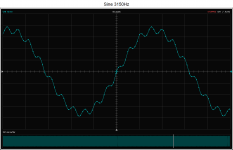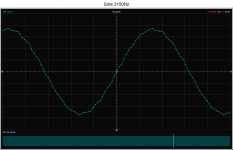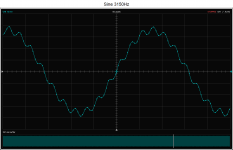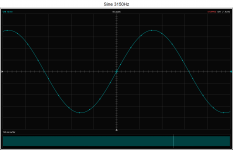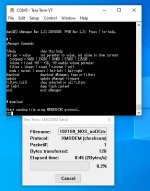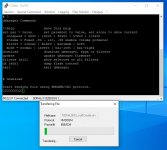I use this, and it works.
https://www.amazon.com/dp/B094G8NY4...9Y2xpY2tSZWRpcmVjdCZkb05vdExvZ0NsaWNrPXRydWU=
https://www.amazon.com/dp/B094G8NY4...9Y2xpY2tSZWRpcmVjdCZkb05vdExvZ0NsaWNrPXRydWU=
You have cheap 2 euro USB TTL devices with wires attached that work excellently. You can stick them in the headers without soldering. I think I put a link somewhere in the Soekris build thread...
This filters set is an attempt to bring better pseudo NOS to Soekris R2R dacs family.
First two filter F4 and F5 are more classical approach with zero padding on first stage and band limiting on second.
The F6 and F7 filters are a slightly different approach with better results from my perspective.
There is no IIR and even deemphasis just pure FIRs
Funny as I'm listening a second evening, I'm liking F6/F7 more than yesterday (although I'm still tempted to say I like F4/F5 better). I'll let you know more after a while.
So I understand the zero-order hold on the F4/F5. What's the "different approach" you mention for F6/F7?
Last edited:
I will try to explain it widely later depending onresults and feedback.
I just prepared improved version of filters F6/F7 and F5 with very litte anti-imaging. This filter set is intended for CD quality 44.1kHz only, other frequency may work but performance will be suboptimal for sure. It's for evaluation especially to compare with other real NOS dacs.
I just prepared improved version of filters F6/F7 and F5 with very litte anti-imaging. This filter set is intended for CD quality 44.1kHz only, other frequency may work but performance will be suboptimal for sure. It's for evaluation especially to compare with other real NOS dacs.
Attachments
I'll check it out. 16-bit 44.1 kHz is all I listen to anyway, so that's fine for me.
Are the differences between F4-F5 and F6-F7 just in the roll-off?
Last nights I had some background noise and was unable to hear differences between those pairs. And indeed if it's a few dB roll-off above 16 kHz or so then I don't think I can hear that anymore.
Are the differences between F4-F5 and F6-F7 just in the roll-off?
Last nights I had some background noise and was unable to hear differences between those pairs. And indeed if it's a few dB roll-off above 16 kHz or so then I don't think I can hear that anymore.
NOS is easier when played(observed) with exactly same frequency as it was captured. When we upsample to higher frequency we have to decide what to do, reconstruct or in case of NOS (zoh), how many mirror images we want.More mirrors wider bandwith, better reconstruction but our staired wave. So we just geting better picture of stairs. So diferences beetween filters are just to find optimal solution for that problem. Holo Dac for instance allow multiple images. F4 is more reconstruction, F5 is native so all images pass just auttentuated ,F6 and F7 is hard limited to just one image. There is some other stuff I also trying after failure with excesive computation and low precision in previous filters.
Attachments
I use this, and it works.
https://www.amazon.com/dp/B094G8NY4...9Y2xpY2tSZWRpcmVjdCZkb05vdExvZ0NsaWNrPXRydWU=
I have just got the adapter you have linked but I cannot get it working.
Can you please tell me precisely how you have configured and connected the adapter?
Thank you
Finally I got the USB adapter working via J3.
I get the uManager and I'm able to download the filter but:
- using Tera Term the data are not sent because file transfer starts and freezes
- using Extra Putty file transfer never ends, it restars as soon as all the packets are sent
Any help?
I get the uManager and I'm able to download the filter but:
- using Tera Term the data are not sent because file transfer starts and freezes
- using Extra Putty file transfer never ends, it restars as soon as all the packets are sent
Any help?
Attachments
@gumisb Your latest pack bring the sound of F6/F7 a *lot* closer to F4/F5. Well done, if that was the goal! I'll have to listen longer and more critical to point out the differences now.
Thanks. In fact, the goal was to create a filter that is perfectly limited (F6 / F7) to one image and compared to other methods. If we assume that our frequency resolution is limited to the 20-20kHz band and / or our output stage has similar limitations, the difference should not be noticeable.
There is of course evidence that ultrasonic sounds do influence perception and perhaps fatigue, but I can’t pass judgement on that yet.
FIR / Room correction
The soekris dac is using 4k taps FIR filters for implementing a lowpass filter.
Right now i'm using the 13 biquad filters for room correction.
But I was thinking,
Would it be possible to use the FIR1 filter bank to do a few things more?
- Frequency correction
- Phase correction
- Lowpass filter
What I mean is something like this:
https://rephase.org/tutorials/Bear_REW_rePhase_tuto.pdf
I'm out of my comfort zone regarding knowledge about FPGA/FIR, and so on. So I'm not sure if I overlooking some important rules.
The soekris dac is using 4k taps FIR filters for implementing a lowpass filter.
Right now i'm using the 13 biquad filters for room correction.
But I was thinking,
Would it be possible to use the FIR1 filter bank to do a few things more?
- Frequency correction
- Phase correction
- Lowpass filter
What I mean is something like this:
https://rephase.org/tutorials/Bear_REW_rePhase_tuto.pdf
I'm out of my comfort zone regarding knowledge about FPGA/FIR, and so on. So I'm not sure if I overlooking some important rules.
I tried that i.e. to combine LP + EQ. I ran out of taps as it where. You may be lucky. It did play.
//
//
Does Rephase warn you when you're running out of taps or does MKROM return a fault? I understand that my questions are at the bottom of the FIR ladder..
Edit: I understand the limitation is visible when you generate an impulse in rephase and compare the target curve and actual curve.
So the lower the amount of taps the more limitations in the low freqency area?
Best practice could be still using the biquads in the <200hz area....
Edit: I understand the limitation is visible when you generate an impulse in rephase and compare the target curve and actual curve.
So the lower the amount of taps the more limitations in the low freqency area?
Best practice could be still using the biquads in the <200hz area....
Last edited:
In rePhase you enter available number of taps. I think you will see a red trace of what you actually will get from your desired black trace, once you start generating an output. You can watch it in real time as the red trace is trying to match the black one...
//
//
What would be a good starting point as a lowpass filter?
I prefer the F7 soft stock filter.
I did read somewhere that the F7 filter is a (soft) butterworth style filter.
When I take a look at the original filter file from Soren then this is in the comments of the F7 filter ((44.1 Ksps, 21.5 Khz - 1 db, 36 db/oct)
I'm I in the good direction with this filter for 44.1Khz?
- Rephase Minimum-Phase Filter tab
- mode: Normal
- type: Low-pass
- shape: Butterworth
- param: 36dB/oct
- Freq: 24Khz (gives a -1dB attenuation on 21.5khz)
Thanks for the help.
I prefer the F7 soft stock filter.
I did read somewhere that the F7 filter is a (soft) butterworth style filter.
When I take a look at the original filter file from Soren then this is in the comments of the F7 filter ((44.1 Ksps, 21.5 Khz - 1 db, 36 db/oct)
I'm I in the good direction with this filter for 44.1Khz?
- Rephase Minimum-Phase Filter tab
- mode: Normal
- type: Low-pass
- shape: Butterworth
- param: 36dB/oct
- Freq: 24Khz (gives a -1dB attenuation on 21.5khz)
Thanks for the help.
Been listening to TNT's filter from #1633 for almost a year now. Finally got around to connecting the DAC to the old laptop again and tried #1833. Very interesting! High end sounds more natural/open and less smeared/phasey and midrange a little more uncluttered, but it's also really top end heavy (auditioning on my studio monitors) and more fatiguing. Fast attack midrange stuff (like toms) and certain vocals seem to jump out a little.
Sounds great for orchestral stuff, soundtracks and generally everything that is rather mellow. Original Twin Peaks soundtrack sounds just perfect. ;-) Things like certain 90s pop productions can sound harsh to the point of being unlistenable though.
Whitney Houston's voice on "I will always love you" sounds nice and full with the #1633 filter, but peaky and unnerving with the #1833 filter.
It's taken some time for me to return back to the 1021 filters. I agree with this assessment. I had the #1833 filter (noDC) for over a year and found it a little top heavy and slightly thin in upper ranges. I finally switched back to the earlier TNT v2 filters (1633?) yesterday and everything is right again...
- Home
- Source & Line
- Digital Line Level
- Filter brewing for the Soekris R2R
